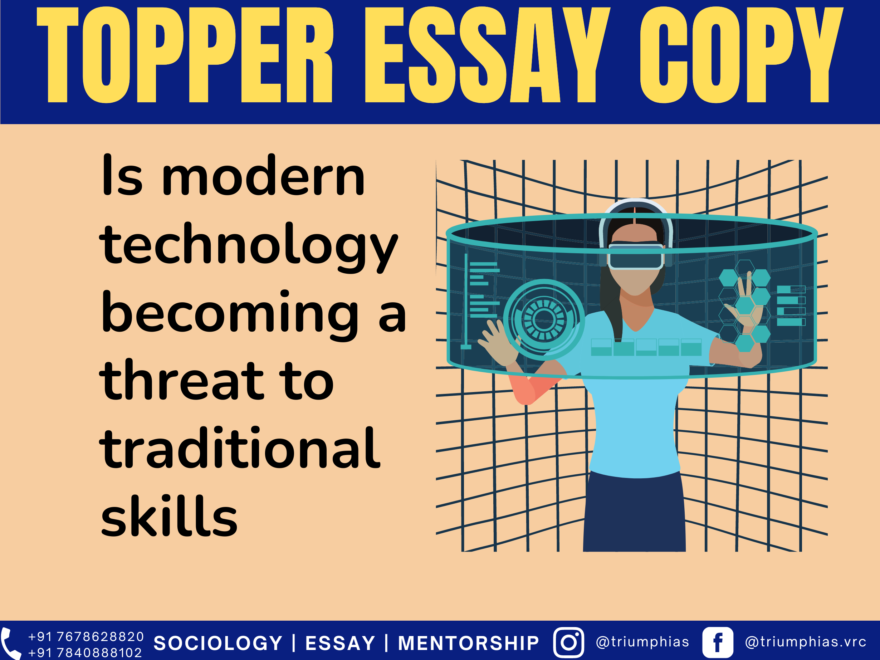IAS, DIVYA MISHRA

Essay Topic:
Is modern technology becoming a threat to traditional skills
(Relevant for Essay Writing for UPSC Civil Services Examination)
Is modern technology becoming a threat to traditional skills“Our silk is losing market,” said a silk weaver from Bihar, famous for its muga silk. But this is not an isolated case. India, endowed with all varieties of silk i.e. Mulberry, tasar, muga, eri, is witnessing a decline in domestic and export sales. The primary reason often cited is inundation by cheaper, brighter Chinese silk… Weavers of silk in Karnataka, Bihar, Assam, Meghalaya, and Tamil Nadu are facing a livelihood crisis with the plummeting market share of their products. Whereas, the silk produced by modern machines with modern technology is much cheaper, affordable, and enhanced aesthetically. The care of handicrafts men in India like Banaras, Pochampally, and Kanchipuram is no different. Greater advancements in textile technology e.g. power looms – rapier, airjet, waterjet weft insertion with Jacquard patterning are capable of producing multiple and large quantity shades. In a war prima facie, it seems like modern technology is becoming a threat to traditional skills. But this thesis demands a thorough review. In this essay, we are firstly trying to understand what are the traditional skills threatened by modern technology? Is this a unilateral and irreversible phenomenon? Or, in some cases, improved and upgraded traditional skills are also finding their place in the modern world? What is the rationale of this cyclical pattern? Where are we collectively supposed to be heading? The traditional skills The Indian subcontinent is a land of rich culture and heritage. People in the Indus Valley civilization used to make beads with steatite, bangles, Cain-shaped seals, sculptors like the Dancing girl in Mohenjo-Daro, terracotta figurines like the taycart in Harappa. Gupta age. Kanishka, Harshavardhan were famous for their numismatic art. Indian muslin, cotton-made fabric with paper-like thinness was in soaring demand in 16th – 17th-century Europe, which brought colonial paves to our shores. Leather products, ivory craft, pottery, etc., were a culmination of human artisanship in world history. Even the temple making styles of Nagara and drarirda style with large pyramidal gopuram, intricate carving bear testimony and generate awe i.e. Meenakshi temple (Madurai), Kailashnath temple (Khajuraho, MP). But with changing wheels of time, Industrial revolution III and now IV in the 21st century, a change is witnessed. What was important and relevant in the past may not serve the same utility and have the same value today. However, it does not mean that the centuries of depositary of traditional skills and craft are to be discarded. In the next section, we will see the dynamics of these changes. A discourse on modern technology and traditional skills Recent employment – unemployment survey by Labour berceuse has reported that traditional artisans and handicrafts men are leaving their occupation. A study by ‘Indian council of social studies’ showed that 65% of the youth of the next generation of artisans doesn’t want to continue in the traditional home business. Relatedly, India’s silk exports and handicrafts are declining year on year. Experts reason that this fall in demand is due to over-expensive and inferior quality of these products who do not enjoy economies of scale of production which machine-made products do. However, the argument given above is not entirely inclusive of the current dynamics between ‘modern technology – traditional skills’. Many traditional methods like pietra – Dura technique of sculptor making practiced in ancient India, skill continues in Ajmer, Deogarh. Besides the above art, even in the current situation of water poverty e.g. Chennai water crisis in India, we find refuge in traditional methods like Baoli, Zohad, Khadins (Rajasthan), oonaris (Tamil Nadu), Ahar – pynes (Bihar), etc. Even in Agriculture, with new schemes like ‘Paramparagat krishi vikas yojna’, the government is shifting focus to organic agricultural practices like ZBNF (Zero budget natural farming), PM – JIVAN (Befoul, Biodiesel), etc. Based on arguments given above it can be determined that this preference for modern technology over traditional skills is not a unilateral and irreversible phenomenon. ‘Darwinism’ philosophy holds that “history of human civilization is a history of evolution” which if complemented with dialecticism of Hegel provides some answers. That is, humanity by its very nature looks towards progressive practices to reach a higher state of development. We adopt, accept and practice that technology and those skills which are most relevant and convenient, given our socio-political reality. While Neem coated urea is preferred to deal with nutrient pollution, the use of micro-irrigation, sprinkler technology cannot be denied. India was suffering from food shortages. Only through green revolution, mechanization, high-yield varieties could we ensure food security. But the dysfunctions of green revolution i.e. multiple cropping, agro-climate specific crops etc. Abandoning the practice of using labor for harvesting paddy led to the use of machines. These machines are burning stubble which are leading to stubble burning. The solution to the above problem came from modern technology e.g. Happy seeder machine. So here again through multiple conflicting examples within agriculture it can be seen that the aforementioned relationship is not strict but fluid. Besides agriculture in Indian society, we also see the malice of manual scavenging which is an outcome of caste hierarchy and its philosophy of ‘purity and pollution’. Technology has come to rescue again here. As this tradition can be broken by robotic cleaning. For example Kerala government-funded robot BANDLOOT does the same job with more efficiency. Our patriarchal societal construction confines social mobility of women. Traditionally their unpaid work in home-based industries like pickles, papad, tailoring was not economically rewarded but with modern technological intervention they can study through the internet and enhance their lifetime earnings. Another side of the coin is increasing violence against women. Social media trolling, bullying, blackmailing has increased multifold. Hence the conundrum of modern technology in negative light. It follows also that earlier access to quality and affordable education was a privilege. Census 2011 shows women literacy 65% and men 80%. But with the advent of the internet, MOOCs courses, education is now accessible to all fulfilling SDG goal 3. Not just education but also the Health sector presents this dilemma. AYUSH ministry was set up to promote Ayurvedic, Homeopathic etc traditional methods initiated thousands of years back by Charak and Sushruta. This sector’s size is $6.2 Billion with a potential of becoming $5 Trillion by 2050. Yet only this will not suffice. Modern Technology intervention in tertiary healthcare – surgeries can’t be denied. Recently India became the first country in the world to have performed Tele-Robotic-Heart surgery. Cataract operations through lasers and robotics all have become affordable to masses. Traditional security forces or policing methods of the 19th or 20th century won’t do. As PM said, “we need SMART police” of which being Technology-savvy is a very important part Newer technologic DNA fingerprinting for criminal identification is needed. Modern-day geopolitical concerns are replacing older ways and methods by new technologies like Defiance-missiles, drones, UAVs etc. Even the dependence on monsoon of earlier times requires a shift to better prediction and forecast. Space technology – remote sensing, navigation are effective solutions to that. Recently government unveiled O-NEER for Indian ocean-wind monitoring. Advances in space technology and nuclear technology future. Hence, we come back to traditional systems in an upgraded version. For example, the use of cow dung for biometh |
To master these intricacies and fare well in the Sociology Optional Syllabus, aspiring sociologists might benefit from guidance by the Best Sociology Optional Teacher and participation in the Best Sociology Optional Coaching. These avenues provide comprehensive assistance, ensuring a solid understanding of sociology’s diverse methodologies and techniques
Meta Tags:
Water Resource Management,Water Resource Management,Water Resource Management,Water Resource Management,Water Resource Management,Water Resource Management,Water Resource Management, Water Resource Management,Water Resource Management,Water Resource Management,Water Resource Management

Why Vikash Ranjan’s foundation Classes for Essay?
Proper guidance and assistance are required to learn the skill of writing essay topics in CSE examination. VIKASH RANJAN SIR at TRIUMPH IAS guides students according to the Recent Trends of UPSC, making him the Best Essay Teacher for Essay writing UPSC.
At Triumph IAS, the Best Essay Writing Coaching platform, we not only provide the best study material and applied classes of Essay for IAS but also conduct regular assignments and class tests to assess candidates’ writing skills and understanding of the subject.
Choose The Best Essay Writing Teacher for IAS Preparation and Know our Approach for Essay?
- The Programme is Planned & Executed in a Way that You Write a good Essay for obtaining Effective Score of 140 Plus.
- In this programme we provide Classes on
- How to INTRODUCE The Topic in Context of the THEME of the Essay
- How to Elaborate & Explain the Topic-Theme on Temporal Scale & Sectoral Scale as well as Intellectual Scale in the MAIN BODY of the Essay.
- How to Sum up the Topic in CONCLUSION in Context of the Essay Topic Theme.
- ︎We will Teach You How to use the Knowledge Matrix of General Studies & Optional to write a Good Essay more Logically and Coherently.
- After the Classes You have to “Write to Learn & Learn to Score” .This means You have to Write the Essay Test Papers & Learn from the Feedback & Discussions.
Why Essay is Important and What We Offer in “Essay Test Series”?
- Triumph’s Essay Upgradation Test Series (Under Personal Guidance of Vikash Ranjan Sir) doesn’t only focus on improving student’s linguistic skills but also focus on improving student’s ability to comprehend the topic-sentence (subject) recall & relate the facts, concepts, propose thesis-statements, and logically assimilate the ideas & counter ideas with clarity in expression on temporal & Sectoral Scales of knowledge.
- Further students are provided one-on-one INTERACTION* Session with Vikash Ranjan Sir. Students get personal feedback on their strength and weaknesses, regarding what is ‘good about their essay and what more should be done to make it a better one’ by Vikash Ranjan Sir.
Why to take up this “Essay Test Series and Foundation” Course?
- Essay is Low hanging Fruit. Marks in Essay is Effectively Contributing in Final Selection in New Pattern of Mains Exam. With a Well Developed ‘Knowledge Matrix and Rigorous Practice’, One can Score upto 160 + in Essay. So IAS Aspirants should never Ignore Essay Preparation
- Inculcating Writing Competency in Essay for IAS, which is Different from Essay in English, Essay in School and College.
Follow us :
🔎 https://www.instagram.com/triumphias
🔎https://www.youtube.com/c/TriumphIAS
🔎https://t.me/VikashRanjanSociology
Find More Blogs…
| Compare and contrast Karl Marx’s and Max weber’s | Karl Marx- Historical Materialism |
| Position of Women In the Modern Indian Society | Sociology: Social system and pattern variables |
keyword: Is modern technology becoming a threat to traditional skills,Is modern technology becoming a threat to traditional skills,Is modern technology becoming a threat to traditional skills,Is modern technology becoming a threat to traditional skills,Is modern technology becoming a threat to traditional skills,Is modern technology becoming a threat to traditional skills,Is modern technology becoming a threat to traditional skills,Is modern technology becoming a threat to traditional skills,Is modern technology becoming a threat to traditional skills,Is modern technology becoming a threat to traditional skills,

